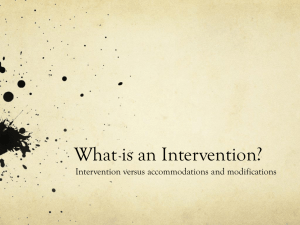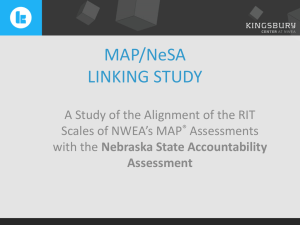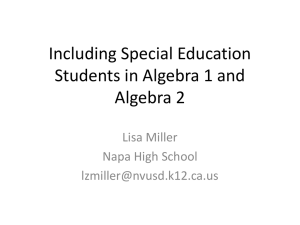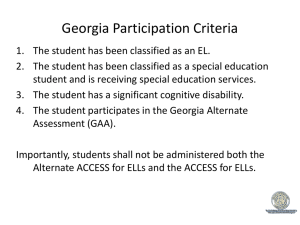MAP ADMINISTRATION TRAINING 2014-2015
advertisement
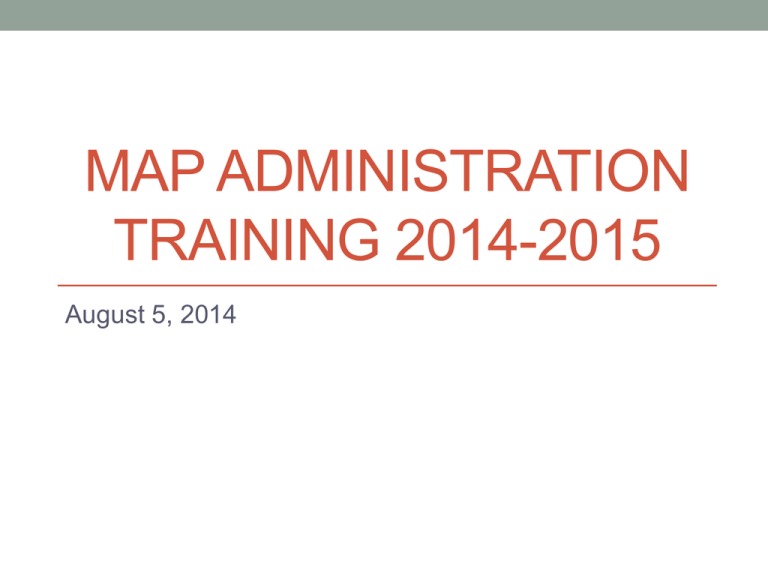
MAP ADMINISTRATION TRAINING 2014-2015 August 5, 2014 What Will Be Covered • MAP Assessment • Policies & Procedures • Accommodations • Scores • SPF • SAL, Proctor, & STR Responsibilities • What’s New/Different in Web-based MAP • Reports • Resources • MARC Overview Housekeeping • Please sign-in • What’s in your folder • Forms • Resources • Staff Training • Deadlines MAP Deadlines STR Device Readiness Verification Form due 8/8/14. Staff Training Sign-in Sheet due prior to the start of any MAP testing. MAP Login Request Form due prior to the start of any MAP testing. All completed forms can be emailed to MacKenzie Lane @ mackenzie_lane@dpsk12.org MAP Assessment What is MAP • MAP: Measures of Academic Progress in mathematics, reading and language. • Aligned to the Common Core State Standards • Computer adaptive; 39-52 questions per subject area • Data driven • Administered 3 times each year Why we use MAP • Instruction: • inform in-the-moment instructional practices • track student growth from fall to spring • provide insight into college and career readiness • provide valid growth data • Accountability: • measure of school performance on the Alternative SPF Who takes MAP • ALL students in grades 6-12 enrolled in an alternative school during the testing window are required to take all MAP tests (mathematics, reading, and language) 2014-2015 Assessment Windows • FALL: 8/11/14-11/21/14 • WINTER: 12/1/14-2/20/15 • SPRING: 3/2/15-6/5/15 • SUMMER: 6/15/15-7/31/15 *Schools are allowed to create their own testing schedules as long as all of the tests are administered within the window. Be sure to allow enough time for any rescheduled tests and re-tests. Policies & Procedures 2014-2015 MAP Policies • ALL students in grades 6-12 enrolled at the school during the testing window must take all MAP tests. • A student should only test in 1 subject per day. • Allow 65 minutes per testing session (50 minutes for administration and 15 minutes for preparation between groups). • Tests are NOT timed. All students should be given adequate time to complete their assessments. Tests may be stopped with an option to resume at another time. • Students who are absent must be rescheduled during the testing window. • A student who receives an invalid test score will be required to re-test during the window. 2014-2015 Policy Changes • ARE will no longer send weekly analysis or not yet tested report to schools. • Test duration under 15 minutes will no longer be flagged for a re-test. Tests that do not meet the required duration set by MAP (6 minutes) will be indicated on testing reports. • Schools will be responsible for pulling testing reports to identify students who have an invalid test and must re-test. • Schools will also be responsible to pulling testing reports to identify students who have not yet tested. • ARE will still conduct weekly analysis of scores and will contact schools with any questions or concerns. MAP Ethics • Understand the procedures needed to administer the assessment. • Avoid any conditions in the preparation and administration that might invalidate the results. • Ensure that any eligible student is not excluded from taking the assessment. • Ensure that all students who need an accommodation are afforded one according to policies and procedures. • Protect the rights to privacy of all examinees. • Avoid actions or conditions that would permit or encourage an individual to receive scores that misrepresent their actual levels of achievement. Accommodations MAP Accommodations: Standard Presentation Accommodations: • Simplify or clarify directions; for example, clarifying the location of the Next button • Use visual magnification devices or software (for example, MAP is compatible with ZoomText Magnifier 9.1 or MAGic 11) • Use auditory amplification devices, noise buffers, or software • Use masks to block a portion of the screen; for example, the student may use a sticky note, index card, or a blank sheet of paper to move down the screen as he or she is reading • Read or reread aloud the test directions • Read or reread aloud the test questions for math or language usage tests only MAP Accommodations: Standard Response Accommodations: • Scribes, educational assistants, and other people supporting a student during testing must be neutral in responding to the student during test administration. Assistance in test administration must not lead a student to the correct answer. The student’s response must accurately represent the student’s own choice. • Assign a scribe to record responses • Dictate responses to a scribe • Point to responses for a scribe • Respond in native language MAP Accommodations: Standard Setting Accommodations: • Test an individual student in a separate setting • Test a small group of students in a separate setting • Minimize distractions; for example, use a study carrel MAP Accommodations: Standard Timing / Schedule Accommodations: • Administer test over multiple sessions in a day • Administer test over a number of days (limited to 2 days) • Allow flexible schedule • Extend time for testing (all MAP assessments are designed to be untimed for all students) • Administer at time of day most beneficial to student • Offer breaks MAP Accommodations: Standard Materials or Devices Accommodations: • Provide scratch paper • Provide a comparable calculator when a student is unable to access the on-screen calculator given in a question MAP Accommodations: Standard Miscellaneous Accommodations: • Provide a drink during testing • Provide a snack during testing MAP Accommodations: Non-standard Accommodations that have the potential to bias the student’s test score are considered non-standard, and they require special consideration. Examples include: • Native language translation • Reading aloud the answer options • Reading or translating any portion of the reading test • Pronouncing symbols for math • Defining words within the test question • Using a calculator for questions that do not have an onscreen calculator • Any other accommodations not listed above MAP Accommodations: Non-standard • Non-standard accommodations must be listed on the student IEP/504 plan • Accommodation must be used regularly in the classroom and in place no less than 90 days prior to testing Scores MAP Scores: RIT • MAP tests report the student’s Rasch unIT (RIT) score upon completion. • Shows current student level in that subject • Equal-interval score; scores can be added together to calculate accurate class or school averages • RIT scores range from about 100 to 300 • RIT scores show growth from year to year MAP Scores: Mathematics MAP Scores: Reading MAP Scores: Language MAP: SEM • Standard Error of Measurement (SEM) is an estimate of the achievement of a test score. • If a single student were to take the same test repeatedly (with no new learning taking place and no memory of question effects), their test scores would likely fall within a given range each time. The SEM represents the probability that the actual score for the student lies within this range. • The smaller the SEM, the more precise the achievement estimate is. Test Invalidations Student Invalidations: • copies or receives verbal help from another student • answers randomly without reading questions • refuses to take or continue the test • seems unable to comprehend directions or questions, exhibits disabling anxiety, or becomes ill during the test Score Invalidations: • RIT score does not fall between 100 and 350 • Test duration is too short: score attained in under 6 minutes • Standard Error of Measurement (SEM) is outside the acceptable limits: SEM is less than 1.5 or above 5.5. If the RIT score is above 240, the SEM above 5.5 is acceptable • Test is terminated without the option to resume Test Invalidations • Records with invalid scores are retained in the database, but are not included in any class, school, or district reporting. • Records with invalid scores are included on test reports (Class Report), but will appear in gray font without a numeric score. • A student who receives an invalid score must re-test within the window. Schools are responsible for identifying these students on testing reports. Test Invalidations • If a student takes the same test twice and one is invalid and the other valid, the student’s name will appear twice on the reports. The invalid score will appear in gray font. • If a student takes the same test twice and both are valid, both scores will appear on the reports. The score that will be used for data purposes will be the score with the lowest SEM and will be in black font. The score that will NOT be used will be in gray font. SPF MAP SPF • MAP is a measure of student progress over time (growth) on the Alternative SPF. • 20% of the school’s overall SPF rating. • Students with at least two valid scores in the same school in the same year with at least 40 consecutive instructional days between the earliest and latest tests are included. • Minimum requirement of 16 eligible growth measures to be included in calculations. • Growth is measured separately for mathematics, reading, and language. • Three years of data are used in SPF calculations. MAP SPF Growth Targets • MAP growth expectations are based on the RIT scale score. • It is determined if a student met or exceeded growth expectations by comparing RIT Scale scores. • The RIT scale score from the earliest test is referenced against a growth expectations table to determine what the expected RIT scale score should be for the latest test based on the number of weeks between tests. MAP SPF Growth Targets Grade Level Test Measure Lower RIT Range Upper RIT Range 8 Weeks 16 Weeks 24 Weeks 32 Weeks 07 Language Usage 0 217 1 1 2 3 07 Mathematics 0 225 2 3 4 5 07 Reading 0 217 1 2 2 3 08 Language Usage 218 220 1 1 2 3 08 Mathematics 226 230 2 2 3 4 08 Reading 218 220 1 2 2 3 09 Language Usage 221 221 1 1 2 3 09 Mathematics 231 233 1 2 2 4 09 Reading 221 222 1 1 2 2 10 Language Usage 222 223 1 1 2 3 10 Mathematics 234 237 1 1 2 2 10 Reading 223 226 1 1 2 2 11 Language Usage 224 225 1 1 2 2 11 Mathematics 238 239 1 1 2 2 11 Reading 227 227 1 1 2 2 12 Language Usage 226 262 1 1 2 2 12 Mathematics 240 286 1 1 1 1 12 Reading 228 266 1 1 1 1 MAP SPF: Examples Target RIT Growth Targets Pre-test RIT grade K-7th (<226) 8 (226-230) 9 (231-233) 10 (234-237) 11 (238-239) 12 (239+) K-7th (<218) 8 (218-220) 9 (221-222) 10 (223-226) 11 (227) 12 (227+) K-7th (<218) 8•(218-220) 9 (221) 10 (222-223) 11 (224-225) 12 (225+) 8-15 16-23 wks wks Mathematics 2 3 2 2 1 2 1 1 1 1 1 1 Reading 1 1 1 1 1 1 1 1 1 1 1 1 Language Arts 1 1 1 1 1 1 1 1 1 1 1 1 Students 24-31 wks 32+ wks 4 3 2 2 2 1 5 4 4 2 2 1 2 2 2 2 2 2 3 3 3 3 2 2 2 2 2 2 2 2 3 3 3 3 2 2 Example 1: Student A scores a 200 on his first/pre-test math test. He stays at Vista Academy for 20 weeks. His expected growth target would be 3 RITs for a final score of at least 203. His score remains the same at 200. Thus, he did not meet his growth target and would be counted negatively. Example 2: Student B scores a 219 on his first/pre-test reading test. He stays at Emily Griffith for 30 weeks. His expected growth target would be 2 RITs for a final score of at least 221. He scores 222. Thus, he meets his growth target and would be counted positively. SAL, Proctor & STR Responsibilities SAL Responsibilities Two weeks prior to testing: Create a master schedule for testing sessions, proctors, equipment, and locations Deliver proctor/teacher training prior to the start of any MAP testing. Completed training sign-in sheet must be returned to mackenzie_lane@dpsk12.org prior to the start of any MAP testing. Coordinate with your STR to ensure device readiness Ensure all proctors have access to MARC (MAP admin site) Plan for any standard accommodations SAL Responsibilities One week prior to testing: Confirm list of students for testing Plan ahead for students with special needs Provide teachers with a copy of master testing schedule Verify that all computers are available for testing and are in working order Create test sessions in MARC SAL Responsibilities Day of testing: Verify that all computers are set to the correct date and time Remove/cover any posters or board information that would aid students Provide scratch paper and pencils for the mathematics tests Place a Do Not Disturb sign on the door Ask teachers to remind students to bring a book to read or class work to complete when they are finished with their test Proctor Responsibilities Day of testing: Launch the MAP browser on student testing devices Log in to MARC Write the Test Session Name and Password on the board Make a note of absent students Read student directions aloud to students prior to starting the test Provide a comparable test environment for all students – ensure that exactly the same information is given to all students Confirm students to test using the MARC dashboard Observe and monitor students during testing. If necessary advise students to slow down or to continue to make progress Proctor Responsibilities Monitor test session – students should not visit or have access to reference books, websites or other instructional material during testing Clarify directions if needed Record student scores if desired – either print or write down scores as students finish Students may read a book when finished with their assessment Students may be dismissed when 90% of the class has completed testing - determined site by site and by the master testing schedule Collect all scratch paper and dispose of it STR Responsibilities One month prior to testing: Download and distribute the MAP lockdown browser to all testing computers Check if each computer meets requirements by starting its lockdown browser Prep any Chromebook or ipads for testing (lockdown browser is not required) STR Responsibilities One week prior to testing: Verify that there are enough testing devices Verify that all devices are in working order Complete the STR Device Readiness Verification From by 8/8/14 and return to MacKenzie Lane @ mackenzie_lane@dpsk12.org Web-based MAP What’s New in Web-based MAP • MAP Admin & Reporting Center (MARC): www.teach.mapnwea.org What’s New in Web-based MAP • MAP Student Testing Center (MSTC): www.test.mapnwea.org What’s New in Web-based MAP TEST NAMES OLD NEW Math Survey w/ Goals 6+ CO MAP: Math 6+ CO 2010 (CCSS) Reading Survey w/ Goals 6+ CO MAP: Reading 6+ CO 2010 (CCSS) Language Survey w/ Goals CO MAP: Language 2-12 CO 2010 (CCSS) What’s New in Web-based MAP • No more nightly uploads • Roster files will be updated weekly • Student scores will be uploaded immediately • Test will now automatically be terminated if not resumed within 14 days • Only the appropriate tests will be available for each student – tests can be pre-assigned • Student test can be paused from the student computer • Students can choose their name when signing in Web-based Enhancements • Students have an improved calculator • Students can reset a test question (refresh browser) • Student can attempt to resume testing in the event of internet failure or technical issue • Software issues have been updated (frozen questions, status not updated) Web-based Technology Requirements Web-based Technology Requirements New Lockdown Browsers: • Windows: https://implementations- admin.mapnwea.org/contents/partner/Setup%20Lockdow n%20Browser.exe • Mac: https://implementations- admin.mapnwea.org/contents/partner/Lockdown%20Brow ser.dmg What’s New Overview Video presentation: https://nwea.adobeconnect.com/_a203290506/testingdiff Reports MAP Reports MAP Reports MAP Reports: Class Report MAP Reports: Class Report Gray text identifies invalid tests as well as tests that are valid but do not provide growth data. MAP Reports: Achievement Status and Growth report MAP Reports: Achievement Status and Growth report Resources MAP Resources • https://nwea.adobeconnect.com/mapessentials MAP Resources Indicates a handout MAP Resources • https://nwea.adobeconnect.com/mapessentials MAP Resources Indicates a handout MAP Resources Use the Help button from any page in MARC to find help guides for that content. Technology Resources MAP System and Technology Guide: http://www.nwea.org/resources/PGM2_System_Administrat ion_Guide.pdf MAP Resources NEW! ARE Website: http://testing.dpsk12.org/resources/MAP.html MAP Contact: MacKenzie Lane 720.423.3576 mackenzie_lane@dpsk12.org MARC Overview


